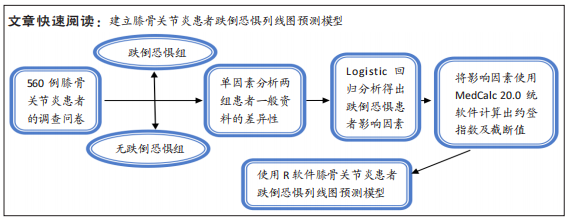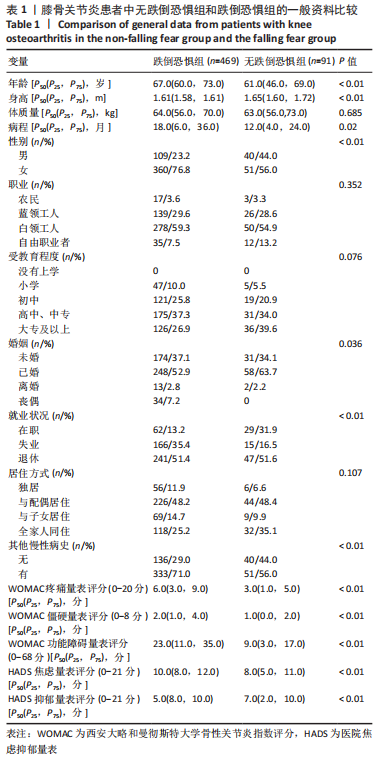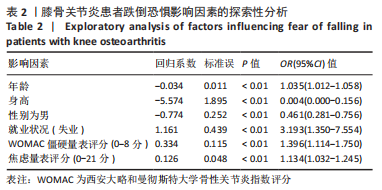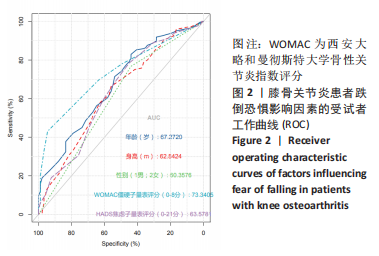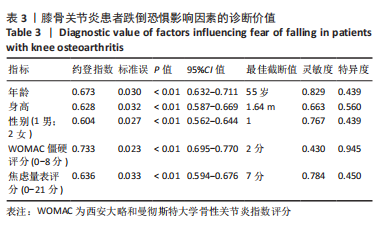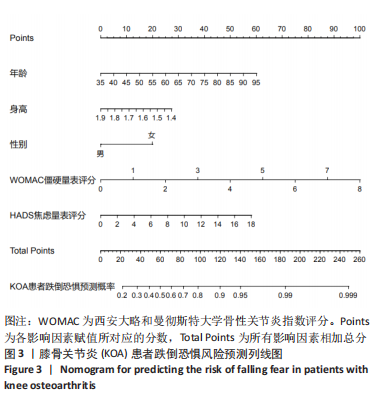[1] SCHEFFER AC, SCHUURMANS MJ, VAN DIJK N, et al. Fear of falling: measurement strategy, prevalence, risk factors and consequences among older persons. Age Ageing. 2008;37(1):19-24.
[2] CUMMING RG, SALKELD G, THOMAS M, et al. Prospective study of the impact of fear of falling on activities of daily living, SF-36 scores, and nursing home admission. J Gerontol A Biol Sci Med Sci. 2000;55(5): M299-M305.
[3] CHU CL, LIANG CK, CHOW PC, et al. Fear of falling (FF): Psychosocial and physical factors among institutionalized older Chinese men in Taiwan. Arch Gerontol Geriatr. 2011;53(2):e232-e236.
[4] 徐艳华,唐起岚,聂贝贝,等.急性缺血性脑卒中偏瘫患者行走步态特征与跌倒恐惧的相关性研究[J]. 中华现代护理杂志,2019, 25(25):3232-3235.
[5] CROSS MJ, MARCH LM, LAPSLEY HM, et al. Patient self-efficacy and health locus of control: relationships with health status and arthritis-related expenditure[J]. Rheumatology (Oxford). 2006;45(1):92-96.
[6] YARDLEY L, SMITH H. A prospective study of the relationship between feared consequences of falling and avoidance of activity in community-living older people. Gerontologist. 2002;42(1):17-23.
[7] THOMPSON DP, MOULA K, WOBY SR. Are fear of movement, self-efficacy beliefs and fear of falling associated with levels of disability in people with osteoarthritis of the knee? A cross sectional study. Musculoskeletal Care. 2017;15(3):257-262.
[8] TURHAN DH, BILIK O, KARAYURT O, et al. Factors related to older patients’ fear of falling during the first mobilization after total knee replacement and total hip replacement. Geriatr Nurs. 2018;39(4):382-387.
[9] TANG X, WANG S, ZHAN S, et al. The Prevalence of Symptomatic Knee Osteoarthritis in China: Results From the China Health and Retirement Longitudinal Study. Arthritis Rheumatol. 2016;68(3):648-653.
[10] 中华医学会骨科学分会关节外科学组.骨关节炎诊疗指南(2018年版)[J].中华骨科杂志,2018,38(12):705-715.
[11] ZHANG H, SI W, PI H. Incidence and risk factors related to fear of falling during the first mobilisation after total knee arthroplasty among older patients with knee osteoarthritis: A cross-sectional study. J Clin Nurs. 2021;30(17-18):2665-2672.
[12] NGUYEN US, FELSON DT, NIU J, et al. The impact of knee instability with and without buckling on balance confidence, fear of falling and physical function: the Multicenter Osteoarthritis Study. Osteoarthritis Cartilage. 2014;22(4):527-534.
[13] BELLAMY N, BUCHANAN WW, GOLDSMITH CH, et al. Validation study of WOMAC: a health status instrument for measuring clinically important patient relevant outcomes to antirheumatic drug therapy in patients with osteoarthritis of the hip or knee. J Rheumatol, 1988;15(12):1833-1840.
[14] SNAITH RP, ZIGMOND AS. The hospital anxiety and depression scale. Br Med J (Clin Res Ed). 1986;292(6516):344.
[15] DESHPANDE N, METTER EJ, LAURETANI F, et al. Activity restriction induced by fear of falling and objective and subjective measures of physical function: a prospective cohort study. J Am Geriatr Soc. 2008; 56(4): 615-620.
[16] AUAIS M, ALVARADO BE, CURCIO CL, et al. Fear of falling as a risk factor of mobility disability in older people at five diverse sites of the IMIAS study. Arch Gerontol Geriatr. 2016;66:147-153.
[17] DESHPANDE N, METTER EJ, BANDINELLI S, et al. Psychological, physical, and sensory correlates of fear of falling and consequent activity restriction in the elderly: the InCHIANTI study. Am J Phys Med Rehabil. 2008;87(5):354-362.
[18] STUBBS B, WEST E, PATCHAY S, et al. Is there a relationship between pain and psychological concerns related to falling in community dwelling older adults? A systematic review. Disabil Rehabil. 2014; 36(23):1931-1942.
[19] SUZUKI M, OHYAMA N, YAMADA K, et al. The relationship between fear of falling, activities of daily living and quality of life among elderly individuals. Nurs Health Sci. 2002;4(4):155-161.
[20] ÇINARLI T, KOÇ Z. Fear and Risk of Falling, Activities of Daily Living, and Quality of Life: Assessment When Older Adults Receive Emergency Department Care. Nurs Res. 2017;66(4):330-335.
[21] GAZIBARA T, KURTAGIC I, KISIC-TEPAVCEVIC D, et al. Falls, risk factors and fear of falling among persons older than 65 years of age. Psychogeriatrics. 2017;17(4):215-223.
[22] JEFFERIS BJ, ILIFFE S, KENDRICK D, et al. How are falls and fear of falling associated with objectively measured physical activity in a cohort of community-dwelling older men? BMC Geriatr. 2014;14:114.
[23] OH E, HONG GS, LEE S, et al. Fear of falling and its predictors among community-living older adults in Korea. Aging Ment Health. 2017;21(4): 369-378.
[24] ZIJLSTRA GA, VAN HAASTREGT JC, VAN EIJK JT, et al. Prevalence and correlates of fear of falling, and associated avoidance of activity in the general population of community-living older people. Age Ageing. 2007;36(3):304-309.
[25] SOYSAL P, TAN SG, SMITH L. A comparison of the prevalence of Fear of Falling between older patients with Lewy body dementia, Alzheimer’s disease, and without dementia. Exp Gerontol. 2021;146:111248.
[26] ANDRESEN EM, WOLINSKY FD, MILLER JP, et al. Cross-sectional and longitudinal risk factors for falls, fear of falling, and falls efficacy in a cohort of middle-aged African Americans. Gerontologist. 2006;46(2): 249-257.
[27] MURRAY CJ, VOS T, LOZANO R, et al. Disability-adjusted life years (DALYs) for 291 diseases and injuries in 21 regions, 1990-2010: a systematic analysis for the Global Burden of Disease Study 2010. Lancet. 2012; 380(9859):2197-2223.
[28] OKA T, ASAI T, KUBO H, et al. Association of fear of falling with acceleration-derived gait indices in older adults with knee osteoarthritis. Aging Clin Exp Res. 2019;31(5):645-651.
[29] TOYODA H, HAYASHI C, OKANO T. Associations between physical function, falls, and the fear of falling among older adults participating in a community-based physical exercise program: A longitudinal multilevel modeling study. Arch Gerontol Geriatr. 2022;102:104752.
[30] BARGIOTAS I, WANG D, MANTILLA J, et al. Preventing falls: the use of machine learning for the prediction of future falls in individuals without history of fall. J Neurol. 2022. doi: 10.1007/s00415-022-11251-3.
[31] 黄丽洁,刘堃,刘永闯,等.社区老年人运动功能与体成分及骨质强度的相关性研究[J].中国现代医学杂志,2017,27(9):91-94.
[32] HOFBAUER LC, SCHOPPET M. Clinical implications of the osteoprotegerin/RANKL/RANK system for bone and vascular diseases. JAMA. 2004;292(4):490-495.
[33] WALKER SP. The ROC Curve Redefined - Optimizing Sensitivity (and Specificity) to the Lived Reality of Cancer. N Engl J Med. 2019;380(17): 1594-1595.
[34] BONNETT LJ, SNELL KIE, COLLINS GS, et al. Guide to presenting clinical prediction models for use in clinical settings. BMJ. 2019;365:l737.
[35] UNVER B, ERTEKIN Ö, KARATOSUN V. Pain, fear of falling and stair climbing ability in patients with knee osteoarthritis before and after knee replacement: 6 month follow-up study. J Back Musculoskelet Rehabil. 2014;27(1):77-84.
[36] NIAN X, HE Y, JI Y, et al. Associations Between Pain Patterns and Self-Reported Clinical Outcomes in Patients with Knee Osteoarthritis. Pain Med. 2019;20(4):818-825.
[37] GUNN AH, SCHWARTZ TA, ARBEEVA LS, et al. Fear of Movement and Associated Factors Among Adults With Symptomatic Knee Osteoarthritis. Arthritis Care Res (Hoboken). 2017;69(12):1826-1833.
[38] 王用玉,王晶,薛艳,等.中老年膝骨关节炎患者临床症状与焦虑的相关性研究[J].老年医学与保健,2019,25(5):568-571.
[39] ÖZTÜRK-İ BAYSALHAN, GARIP Y, SIVAS F, et al. Kinesiophobia in rheumatoid arthritis patients: Relationship with quadriceps muscle strength, fear of falling, functional status, disease activity, and quality of life. Arch Rheumatol. 2021;36(3):427-434.
[40] AKYOL Y, ULUS Y, TANDER B, et al. Falls, fear of falling, and associated factors in ambulatory patients with rheumatoid arthritis: A comparative study with healthy controls. Turk J Phys Med Rehabil. 2018;64(3):213-221.
[41] KENDRICK D, KUMAR A, CARPENTER H, et al. Exercise for reducing fear of falling in older people living in the community. Cochrane Database Syst Rev. 2014;2014(11):D9848.
|
